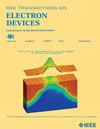基于TETF AlN-on-Si谐振器对的高响应MEMS温度计
IF 2.9
2区 工程技术
Q2 ENGINEERING, ELECTRICAL & ELECTRONIC
引用次数: 0
摘要
在本文中,我们报告了一个由两个三端音叉(TETF)铝硅谐振器组成的MEMS温度计,它使用它们的谐振频率(即拍频)的差异作为温度传感的输出度量。为了提高温度响应性,将两个TETF谐振器设计成具有相似的谐振频率,但温度频率系数(tcf)明显不同。通过设计结构相似的两个谐振器,在相同的振动模式下工作,实现了谐振频率的微小差异。通过在一个谐振腔中引入热应变放大光束,而在另一个谐振腔中添加热应变减小光束,可以实现tfs的巨大差异。此外,两种谐振器采用不同的电极覆盖率,进一步扩大其tfs的差异。理论分析了热应变梁和电极覆盖对tfs的影响,与模拟和实测结果吻合较好。测量结果表明,两种TETF谐振器的谐振频率相差不大(3.45 kHz),而tfs相差较大(868 ppm/°C)。这些特性使温度计达到接近10000 ppm/°C的高温响应度,这被认为是使用节拍频率方法的最先进的谐振温度计中最好的。本文章由计算机程序翻译,如有差异,请以英文原文为准。
A Highly Responsive MEMS Thermometer Based on TETF AlN-on-Si Resonator Pair
In this article, we report a MEMS thermometer comprised of two triple-ended-tuning-fork (TETF) AlN-on-Si resonators, which use the difference in their resonant frequencies (i.e., beat frequency) as the output metric for temperature sensing. To improve temperature responsivity, two TETF resonators are designed to have similar resonant frequencies yet distinctly different temperature coefficients of frequency (TCFs). The small difference in resonant frequencies is achieved by designing the two resonators with similar structures operating in the same vibration mode. The large difference in TCFs is realized by introducing a thermal-strain-amplifying beam to one resonator, while adding a thermal-strain-reducing beam to the other. Moreover, different electrode coverages are applied for the two resonators to further enlarge the difference in their TCFs. Theoretical analysis for the effects of thermal strain beam and electrode coverage on TCFs is provided, which shows good agreement with the simulated and measured results. The measured results show that the two TETF resonators exhibit small difference between their resonant frequencies (3.45 kHz), while having large difference in their TCFs (868 ppm/°C). These characteristics allow the thermometer achieving a high-temperature responsivity close to 10000 ppm/°C, which is considered among the best in the state-of-the-art resonant thermometers using beat frequency method.
求助全文
通过发布文献求助,成功后即可免费获取论文全文。
去求助
来源期刊

IEEE Transactions on Electron Devices
工程技术-工程:电子与电气
CiteScore
5.80
自引率
16.10%
发文量
937
审稿时长
3.8 months
期刊介绍:
IEEE Transactions on Electron Devices publishes original and significant contributions relating to the theory, modeling, design, performance and reliability of electron and ion integrated circuit devices and interconnects, involving insulators, metals, organic materials, micro-plasmas, semiconductors, quantum-effect structures, vacuum devices, and emerging materials with applications in bioelectronics, biomedical electronics, computation, communications, displays, microelectromechanics, imaging, micro-actuators, nanoelectronics, optoelectronics, photovoltaics, power ICs and micro-sensors. Tutorial and review papers on these subjects are also published and occasional special issues appear to present a collection of papers which treat particular areas in more depth and breadth.
 求助内容:
求助内容: 应助结果提醒方式:
应助结果提醒方式:


